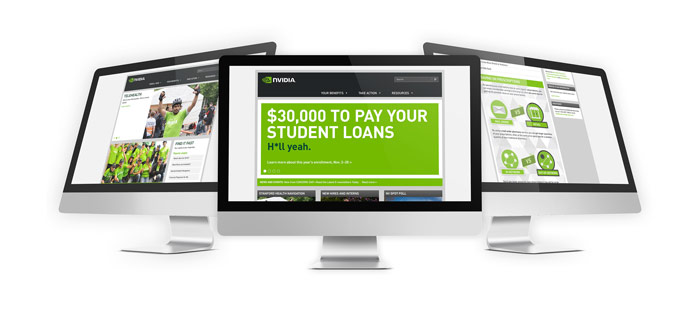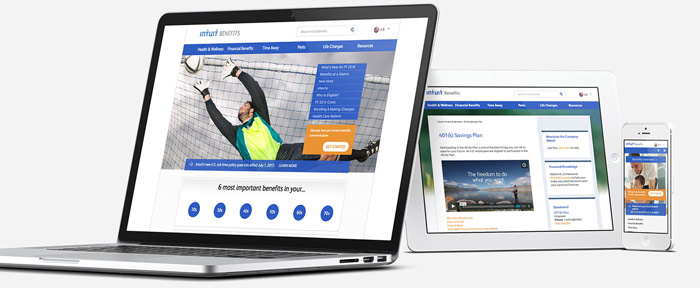
6 Essential elements of a great employee benefits website
Most employers have finally realized that they need to have a benefits website—sometimes called a hub or portal—as a single place online (outside the firewall) to house all their benefits information. But in today’s world, that just isn’t enough. To stay a step ahead of the competition, meet employee expectations, and get the most from your benefits—and website—investment, you need to have a great benefits website.
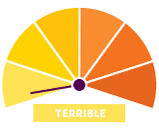 Where does your online experience fall on that spectrum? These six characteristics are what separate a great benefits website from the rest of the pack.
Where does your online experience fall on that spectrum? These six characteristics are what separate a great benefits website from the rest of the pack.
1. Great benefits websites are a branded experience.
A benefits website should be an extension of the entire employee experience—in short, it should look and sound like your company and be an extension of its brand. Your company has probably spent years and millions of dollars building a recognizable, unique brand. Leverage the trust in that brand—and its credibility—by creating a fully branded experience for employees on your benefits website. A word to the wise: Slapping on the company logo and changing a few colors does not create a brand experience! It’s a whole lot more. The tone and style of the copy, the approach to site navigation, the images selected, the page titles—everything on the site should reflect your company’s brand.
Let’s take childcare benefits, for example. If yours is a more traditional brand, you might promote those benefits with content such as, “Get childcare when you need it.” Companies with an edgier brand might push employees to those benefits by saying, “Date night is on!”
What does this look like in action? Check out the work we’ve done with NVIDIA to see a textbook example of leveraging a brand to make a huge impact and drive results.
2. Great benefits websites are accessible all the time, from anywhere.
A website doesn’t do anyone any good if people can’t get to it when they need to. The information on benefits websites needs to be available to employees and their spouses—who often are the benefits decision-makers—when they want it, wherever they happen to be. If, for example, your employee is leaving a doctor’s appointment and wants to access the second opinion referral service that’s included in your benefits, she wants to pull that information up on her mobile device and make the call right then and there. She doesn’t want to have to wait until she returns to her office to use her desktop because privacy might be an issue. It’s no secret that we advocate for—and develop—benefits websites that are built outside the firewall and not hidden behind a password. If you’re still not a convert, tune in to our webinar, Creating Results: Three Steps to Success with Your Benefits Communication, to fully understand why.
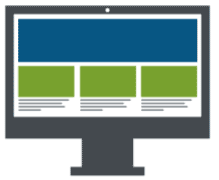
Even so, having a public benefits website isn’t enough in this day and age. Employees expect to be able to get benefits information anytime, from anywhere, which means a great benefits website needs to work on a range of mobile devices. That’s why all the websites we build are responsive; they offer a parallel experience on all devices: phone, tablet, and desktop.
If you have a global presence, don’t forget to include your employees outside of the U.S. Benefits information needs to be immediately available to all employees, whether that employee is in San Francisco, London, or Bangalore. The work we’ve done with Intuit is proof of that. Along with being responsive, Intuit's benefits website now supports 10 countries.
3. Great benefits websites have, um … benefits information on them.
This may sound like a no-brainer, but a great benefits website needs to have a lot of benefits information on it. Employees expect to find everything they need to know about their benefits in one place—their employer’s website. Benefits are more than just medical, dental, and vision. A great benefits website includes information about the full range of benefits offered, including financial wellness and voluntary benefits.
Obviously, any sensitive or personalized info needs to be kept off a public website, but general plan information doesn’t need to be hidden! Ninety-five percent of your benefits information can and should live outside of the firewall, where employees and their spouses can access it when they need it. When employees need to access personalized information, the public website can link them directly to a secure site.
That said, the challenge is to make it simple for employees to find what they’re looking for amid all this info—which brings me to the next feature of a great website.
4. Great benefits websites are easy to use.
It’s pretty much a given that if you’ve delegated the resources to create and maintain a website, you also want employees to be able to use it to find information quickly and easily. Unfortunately, our experience has shown us that when you ask 10 people how to organize benefits information, you get 10 different answers.
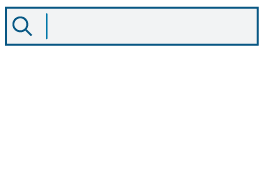
That’s why benefits websites need to be easily searchable. Think of the search function as the primary way employees will navigate the site (most of the time it is), and put the work in to finding common search terms, using predictive and corrective search, and do everything you can to make the search process easy and painless. Another key way to help employees find the info they need is to program an intranet search to include results from the external benefits website as well as your internal site (it’s easier than you think!). That way, if an employee searches the intranet for something benefits-related, the results will show pages and information from your benefits website.
5. Great benefits websites are updated often.
There is no such thing as a one-and-done website. All websites require ongoing maintenance, and benefits sites are no exception. Information on your site needs to be updated often, with new features added, and images refreshed. If any information on the site is out of date, employees will assume all the information on the site is out of date. One of the reasons the web is such a great medium is because websites can be continuously refined, tweaked, and improved. Look at search terms, page visits, and user patterns. Then, use that data to learn how employees are interacting with your site, and fine-tune the user experience.
6. Great benefits websites are promoted all the time.
If a tree falls in a forest and no one is around to hear it, does it make a sound? Can a website be great if no one knows about it? This may not be the forum for such a philosophical discussion, but I know this for sure: For a benefits website to be successful, it must be constantly promoted, talked about, and linked to. Don’t think that just because you build it, your employees will come. Launching your site with a kickoff campaign will get you some initial traffic, but you’ll need a lot more than that for it to become the habit-forming, go-to resource that it needs to be. Make your website the hub of your year-round communications strategy and reference it in all your print materials—email campaigns, social media posts, and other communications—as the spot for more details and more in-depth information. 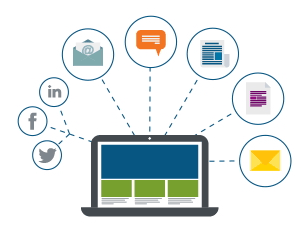 Don’t forget to include the URL in your new hire communications and recruiting materials. Many of our clients dedicate a section of their websites to new hires, and one recently went as far as creating customized information specifically designed for prospective employees. All this promotion may make you feel like you’re repeating yourself, but that’s what it takes to get employees into the habit of visiting your site for the information they need.
Don’t forget to include the URL in your new hire communications and recruiting materials. Many of our clients dedicate a section of their websites to new hires, and one recently went as far as creating customized information specifically designed for prospective employees. All this promotion may make you feel like you’re repeating yourself, but that’s what it takes to get employees into the habit of visiting your site for the information they need.
Easy, right?
Yeah, not so much. Easy is not an adjective we’ve ever used to describe building benefits websites. But valuable and indispensable are. When we take on any new web project, these six characteristics are always top of mind—whether we’re building from scratch or taking an existing site to the next level.
Use them as a starting point for evaluating—and improving—your company’s website. If it comes up short, we can help. Because every company and every employee deserves a great benefits website.
Work with Us
We partner with organizations that value their people first. Let’s talk.

Brian Bookwalter, VP Art Director, serves as the point person for the production of all our video projects and has worked on campaigns across a wide variety of topics.

